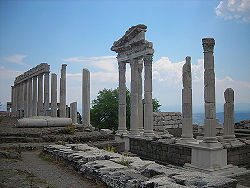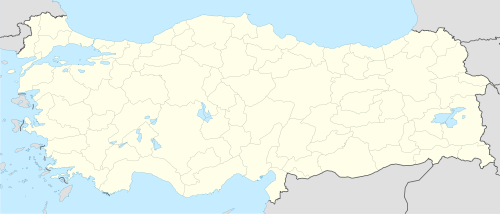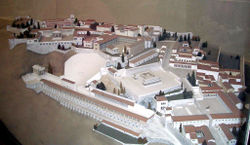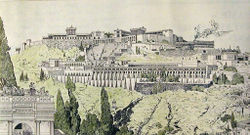Pergamon
| Pergamon (Πέργαμος or Πέργαμον) Ancient Greek City (Bergama) |
|
|---|---|
  Pergamon
Pergamon
|
Pergamon, Pergamum or Pérgamo (in Greek, Πέργαμος or Πέργαμον) was an ancient Greek city in modern-day Turkey, in Mysia, today located 16 miles (26 km) from the Aegean Sea on a promontory on the north side of the river Caicus (modern day Bakırçay), that became the capital of the Kingdom of Pergamon during the Hellenistic period, under the Attalid dynasty, 281–133 BC. Today, the main sites of ancient Pergamon are to the north and west of the modern city of Bergama.
Contents |
History

The Attalid kingdom was the rump state left after the collapse of the Kingdom of Thrace.
The Attalids, the descendants of Attalus, father of Philetaerus who came to power in 281 BC following the collapse of the Kingdom of Thrace, were among the most loyal supporters of Rome in the Hellenistic world. Under Attalus I (241-197 BC), they allied with Rome against Philip V of Macedon, during the first and second Macedonian Wars, and again under Eumenes II (197-158 BC), against Perseus of Macedon, during the Third Macedonian War. For support against the Seleucids, the Attalids were rewarded with all the former Seleucid domains in Asia Minor.
The Attalids ruled with intelligence and generosity. Many documents survive showing how the Attalids would support the growth of towns through sending in skilled artisans and by remitting taxes. They allowed the Greek cities in their domains to maintain nominal independence. They sent gifts to Greek cultural sites like Delphi, Delos, and Athens. They defeated the invading Celts. They remodeled the Acropolis of Pergamon after the Acropolis in Athens. When Attalus III (138-133 BC) died without an heir in 133 BC he bequeathed the whole of Pergamon to Rome, in order to prevent a civil war.
According to Christian tradition, the first bishop of Pergamon, Antipas, was martyred there in ca. 92 AD. (Revelation 2:13)
The Ottoman Sultan Murad III had two large alabaster urns transported from the ruins of Pergamon and placed on two sides of the nave in the Hagia Sophia in Istanbul.[1]
Notable structures
Upper Acropolis



The Great Altar of Pergamon is in the Pergamon Museum, Berlin. The base of this altar remains on the upper part of the Acropolis. It was perhaps to this altar, believed dedicated to Zeus, that John of Patmos referred to as "Satan's Throne" in his Book of Revelation (Revelation 2:12-13).
Other notable structures still in existence on the upper part of the Acropolis include:
- The Hellenistic Theater with a seating capacity of 10,000. This had the steepest seating of any known theater in the ancient world.[2]
- The Sanctuary of Trajan (also known as the Trajaneum)
- The Sanctuary of Athena
- The Library a.k.a. Athenaeum
- The Royal palaces
- The Heroön - a shrine where the kings of Pergamon, particularly, Attalus I and Eumenes II, were worshipped.[3]
- The Temple of Dionysus
- The Upper Agora
- The Roman baths complex
Pergamon's library on the Acropolis (the ancient Library of Pergamum) is the second best in the ancient Greek civilization.[4] When the Ptolemies stopped exporting papyrus, partly because of competitors and partly because of shortages, the Pergamenes invented a new substance to use in codices, called pergaminus or pergamena (parchment) after the city. This was made of fine calfskin, a predecessor of vellum. The library at Pergamom was believed to contain 200,000 volumes, which Mark Antony later gave to Cleopatra as a wedding present.
Lower Acropolis
The lower part of the Acropolis has the following structures:
- the Upper Gymnasium
- the Middle Gymnasium
- the Lower Gymnasium
- the Temple of Demeter
- the Sanctuary of Hera
- the House of Attalus
- the Lower Agora and
- the Gate of Eumenes
At foot of Acropolis
Sanctuary of Asclepius
Three kilometers south of the Acropolis, down in the valley, there was the Sanctuary of Asclepius (also known as the Asclepieion), the god of healing. In this place people with health problems could bathe in the water of the sacred spring, and in the patients' dreams Asclepius would appear in a vision to tell them how to cure their illness. Archeology has found lots of gifts and dedications that people would make afterwards, such as small terracotta body parts, no doubt representing what had been healed. Notable extant structures in the Asclepieion include:
- the Roman theater
- the North Stoa
- the South Stoa
- the Temple of Asclepius
- a circular treatment center (sometimes known as the Temple of Telesphorus)
- a healing spring
- an underground passageway
- a library
- the Via Tecta (or the Sacred Way, which is a colonnaded street leading to the sanctuary) and
- a propylon.
Serapis Temple
Pergamon's other notable structure is the Serapis Temple (Serapeum) which was later transformed into the Red Basilica complex (or Kizil Avlu in Turkish), about one kilometer south of the Acropolis. It consists of a main building and two round towers. In the first century AD, the Christian Church at Pergamon inside the main building of the Red Basilica was one of the Seven Churches to which the Book of Revelation was addressed (Revelation 2:12). The forecourt is still supported by the 193 m wide Pergamon Bridge, the largest bridge substruction of antiquity.[5]
 |
 |
 |
Notable people
- Epigonus (3rd century BC) Greek sculptor
- Aeulius Nicon (2nd century AD) Greek architect and builder
- Galen (ca. 129-200/216) Greek physician
See also
- Allianoi
- List of Roman domes
Footnotes
- ↑ E.J. Brill's first encyclopaedia of Islam, 1913-1936 - Page 526
- ↑ [1] accessed September 24, 2007
- ↑ Bergama (Pergamum)-Akhisar (Thyatira) accessed September 24, 2007
- ↑ after that of Alexandria (see Royal Library of Alexandria)
- ↑ Grewe & Özis 1994, pp. 350, 352
References
- Grewe, Klaus; Özis, Ünal (1994), "Die antiken Flußüberbauungen von Pergamon und Nysa (Türkei)", Antike Welt 25 (4): 348–352
- Hansen, Esther V. (1971). The Attalids of Pergamon. Ithaca, New York: Cornell University Press; London: Cornell University Press Ltd. ISBN 0-8014-0615-3.
- Kosmetatou, Elizabeth (2003) "The Attalids of Pergamon," in Andrew Erskine, ed., A Companion to the Hellenistic World. Oxford: Blackwell: pp. 159–174. ISBN 1-4051-3278-7.
- Nagy, Gregory (1998). "The Library of Pergamon as a Classical Model," in Helmut Koester, ed., Pergamon: Citadel of the Gods. Harrisburg PA: Trinity Press International: 185-232.
- Nagy, Gregory (2007). "The Idea of the Library as a Classical Model for European Culture," http://chs.harvard.edu/publications.sec/online_print_books.ssp/. Center for Hellenic Studies
External links
- Rosa Valderrama, "Pergamum": brief history
- Photographic tour of old and new Pergamon, including the museum
- The Theatre at Pergamon. The Ancient Theatre Archive. Theatre specifications and virtual reality tour of theatre
- Pergamon: City of Science... and Satan: Biblical Archaeology Review
|
|||||
|
||||||||
|
|||||